Roles, Functions, and Theories of Leadership and Management: Report
VerifiedAdded on 2020/06/04
|15
|4750
|194
Report
AI Summary
This report delves into the core concepts of leadership and management, focusing on the roles and characteristics of leaders and managers within a business context, specifically using Marks & Spencer (M&S) as a case study. It contrasts the functions of leaders and managers, emphasizing the importance of both in achieving organizational goals. The report explores the application of leadership and management in diverse business situations, including customer relations, employee management, and societal considerations. It examines various leadership theories, such as system, situational, and contingency leadership, along with their respective strengths and weaknesses. Furthermore, the report addresses the approaches to operations management and its significance in meeting business objectives, highlighting the influence of leaders and managers in improving efficiencies. Finally, it analyzes the elements that influence the decision-making process of leaders and managers within the broader business environment.
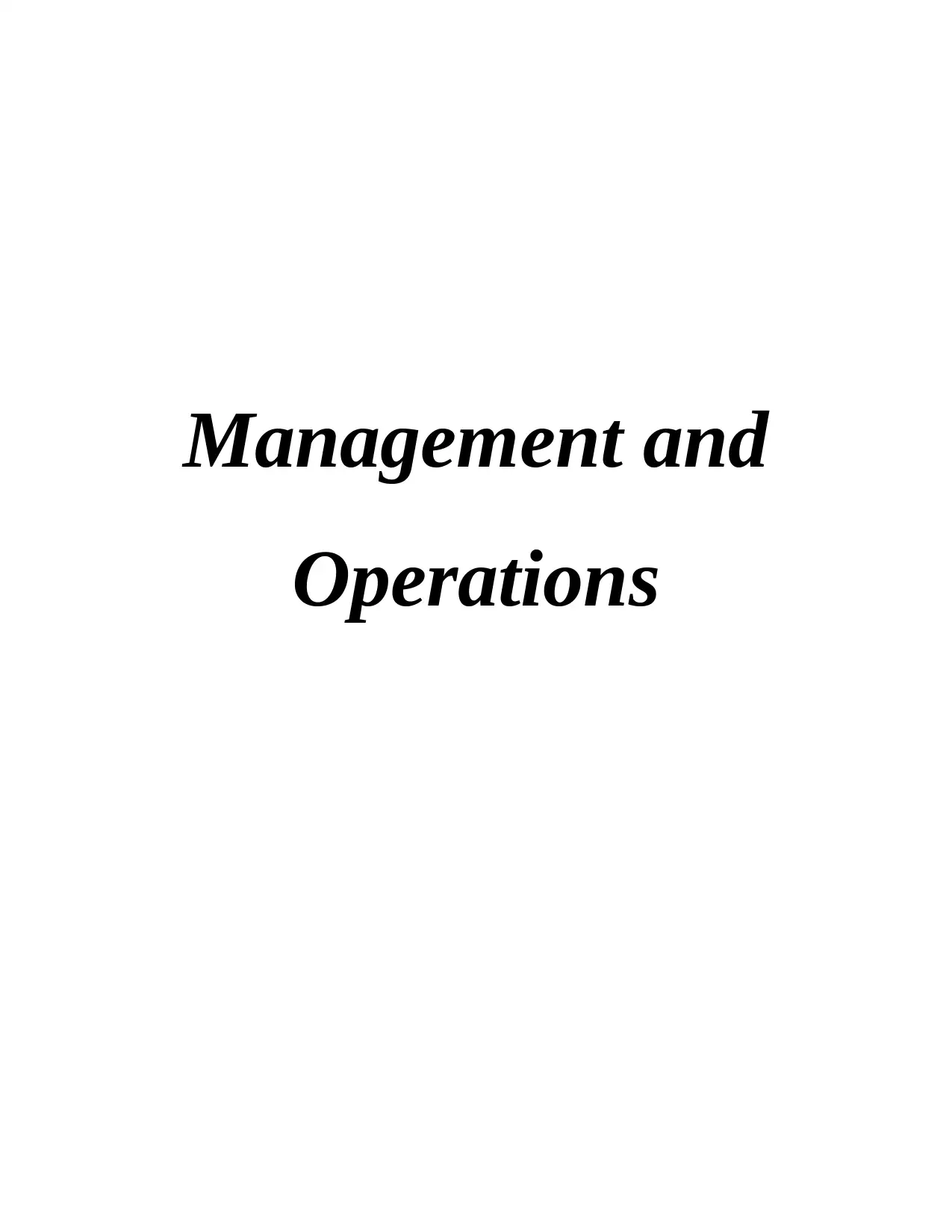
Management and
Operations
Operations
Paraphrase This Document
Need a fresh take? Get an instant paraphrase of this document with our AI Paraphraser
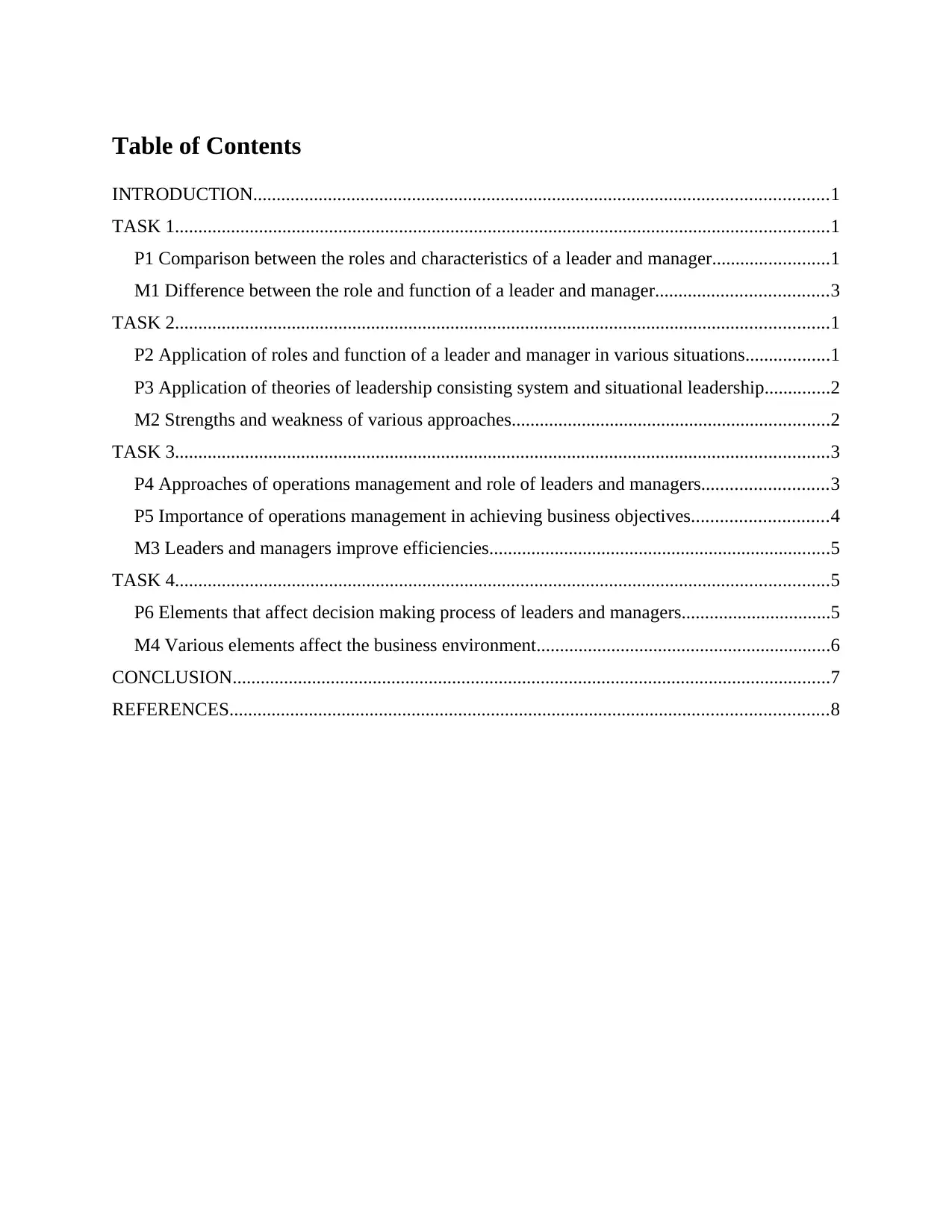
Table of Contents
INTRODUCTION...........................................................................................................................1
TASK 1............................................................................................................................................1
P1 Comparison between the roles and characteristics of a leader and manager.........................1
M1 Difference between the role and function of a leader and manager.....................................3
TASK 2............................................................................................................................................1
P2 Application of roles and function of a leader and manager in various situations..................1
P3 Application of theories of leadership consisting system and situational leadership..............2
M2 Strengths and weakness of various approaches....................................................................2
TASK 3............................................................................................................................................3
P4 Approaches of operations management and role of leaders and managers...........................3
P5 Importance of operations management in achieving business objectives.............................4
M3 Leaders and managers improve efficiencies.........................................................................5
TASK 4............................................................................................................................................5
P6 Elements that affect decision making process of leaders and managers................................5
M4 Various elements affect the business environment...............................................................6
CONCLUSION................................................................................................................................7
REFERENCES................................................................................................................................8
INTRODUCTION...........................................................................................................................1
TASK 1............................................................................................................................................1
P1 Comparison between the roles and characteristics of a leader and manager.........................1
M1 Difference between the role and function of a leader and manager.....................................3
TASK 2............................................................................................................................................1
P2 Application of roles and function of a leader and manager in various situations..................1
P3 Application of theories of leadership consisting system and situational leadership..............2
M2 Strengths and weakness of various approaches....................................................................2
TASK 3............................................................................................................................................3
P4 Approaches of operations management and role of leaders and managers...........................3
P5 Importance of operations management in achieving business objectives.............................4
M3 Leaders and managers improve efficiencies.........................................................................5
TASK 4............................................................................................................................................5
P6 Elements that affect decision making process of leaders and managers................................5
M4 Various elements affect the business environment...............................................................6
CONCLUSION................................................................................................................................7
REFERENCES................................................................................................................................8
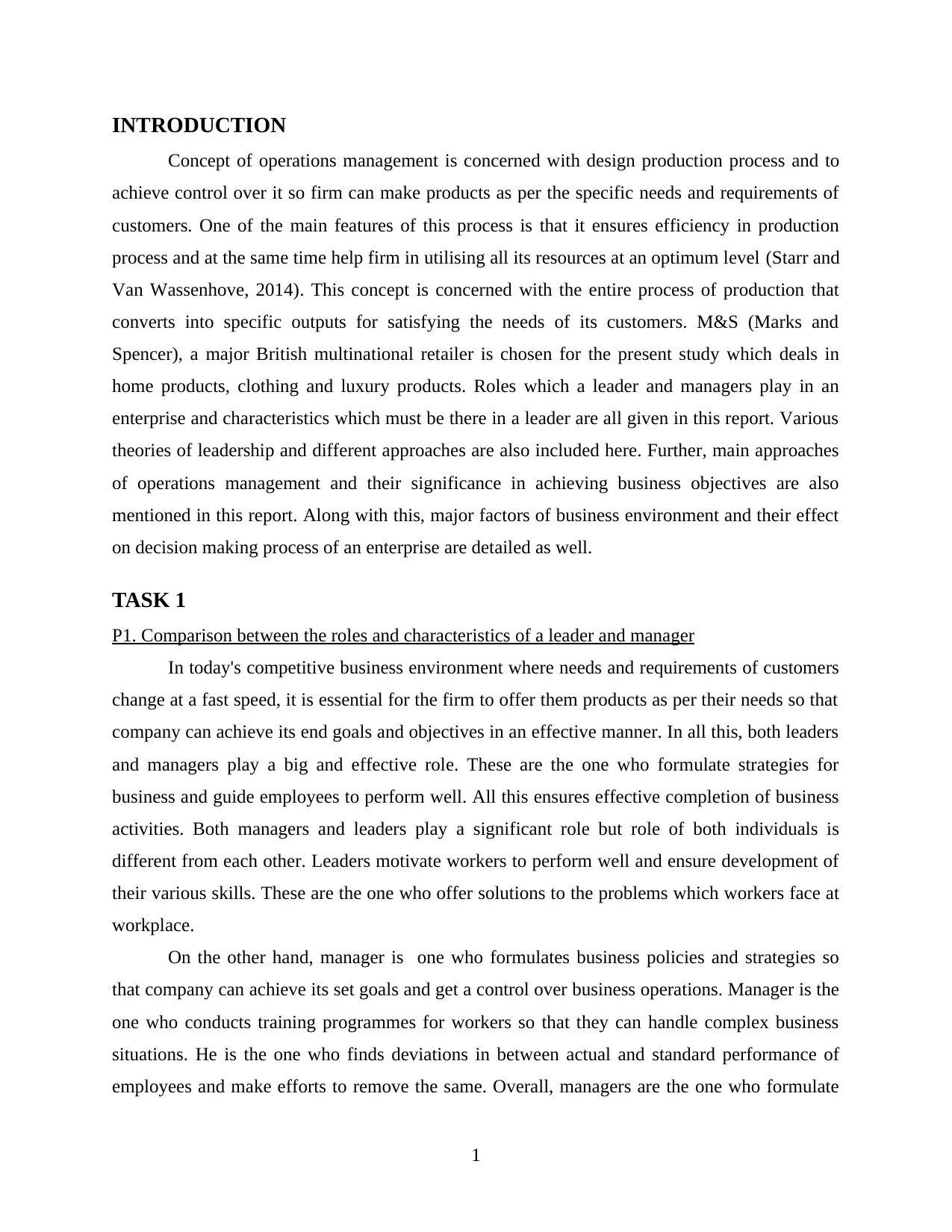
INTRODUCTION
Concept of operations management is concerned with design production process and to
achieve control over it so firm can make products as per the specific needs and requirements of
customers. One of the main features of this process is that it ensures efficiency in production
process and at the same time help firm in utilising all its resources at an optimum level (Starr and
Van Wassenhove, 2014). This concept is concerned with the entire process of production that
converts into specific outputs for satisfying the needs of its customers. M&S (Marks and
Spencer), a major British multinational retailer is chosen for the present study which deals in
home products, clothing and luxury products. Roles which a leader and managers play in an
enterprise and characteristics which must be there in a leader are all given in this report. Various
theories of leadership and different approaches are also included here. Further, main approaches
of operations management and their significance in achieving business objectives are also
mentioned in this report. Along with this, major factors of business environment and their effect
on decision making process of an enterprise are detailed as well.
TASK 1
P1. Comparison between the roles and characteristics of a leader and manager
In today's competitive business environment where needs and requirements of customers
change at a fast speed, it is essential for the firm to offer them products as per their needs so that
company can achieve its end goals and objectives in an effective manner. In all this, both leaders
and managers play a big and effective role. These are the one who formulate strategies for
business and guide employees to perform well. All this ensures effective completion of business
activities. Both managers and leaders play a significant role but role of both individuals is
different from each other. Leaders motivate workers to perform well and ensure development of
their various skills. These are the one who offer solutions to the problems which workers face at
workplace.
On the other hand, manager is one who formulates business policies and strategies so
that company can achieve its set goals and get a control over business operations. Manager is the
one who conducts training programmes for workers so that they can handle complex business
situations. He is the one who finds deviations in between actual and standard performance of
employees and make efforts to remove the same. Overall, managers are the one who formulate
1
Concept of operations management is concerned with design production process and to
achieve control over it so firm can make products as per the specific needs and requirements of
customers. One of the main features of this process is that it ensures efficiency in production
process and at the same time help firm in utilising all its resources at an optimum level (Starr and
Van Wassenhove, 2014). This concept is concerned with the entire process of production that
converts into specific outputs for satisfying the needs of its customers. M&S (Marks and
Spencer), a major British multinational retailer is chosen for the present study which deals in
home products, clothing and luxury products. Roles which a leader and managers play in an
enterprise and characteristics which must be there in a leader are all given in this report. Various
theories of leadership and different approaches are also included here. Further, main approaches
of operations management and their significance in achieving business objectives are also
mentioned in this report. Along with this, major factors of business environment and their effect
on decision making process of an enterprise are detailed as well.
TASK 1
P1. Comparison between the roles and characteristics of a leader and manager
In today's competitive business environment where needs and requirements of customers
change at a fast speed, it is essential for the firm to offer them products as per their needs so that
company can achieve its end goals and objectives in an effective manner. In all this, both leaders
and managers play a big and effective role. These are the one who formulate strategies for
business and guide employees to perform well. All this ensures effective completion of business
activities. Both managers and leaders play a significant role but role of both individuals is
different from each other. Leaders motivate workers to perform well and ensure development of
their various skills. These are the one who offer solutions to the problems which workers face at
workplace.
On the other hand, manager is one who formulates business policies and strategies so
that company can achieve its set goals and get a control over business operations. Manager is the
one who conducts training programmes for workers so that they can handle complex business
situations. He is the one who finds deviations in between actual and standard performance of
employees and make efforts to remove the same. Overall, managers are the one who formulate
1
⊘ This is a preview!⊘
Do you want full access?
Subscribe today to unlock all pages.

Trusted by 1+ million students worldwide
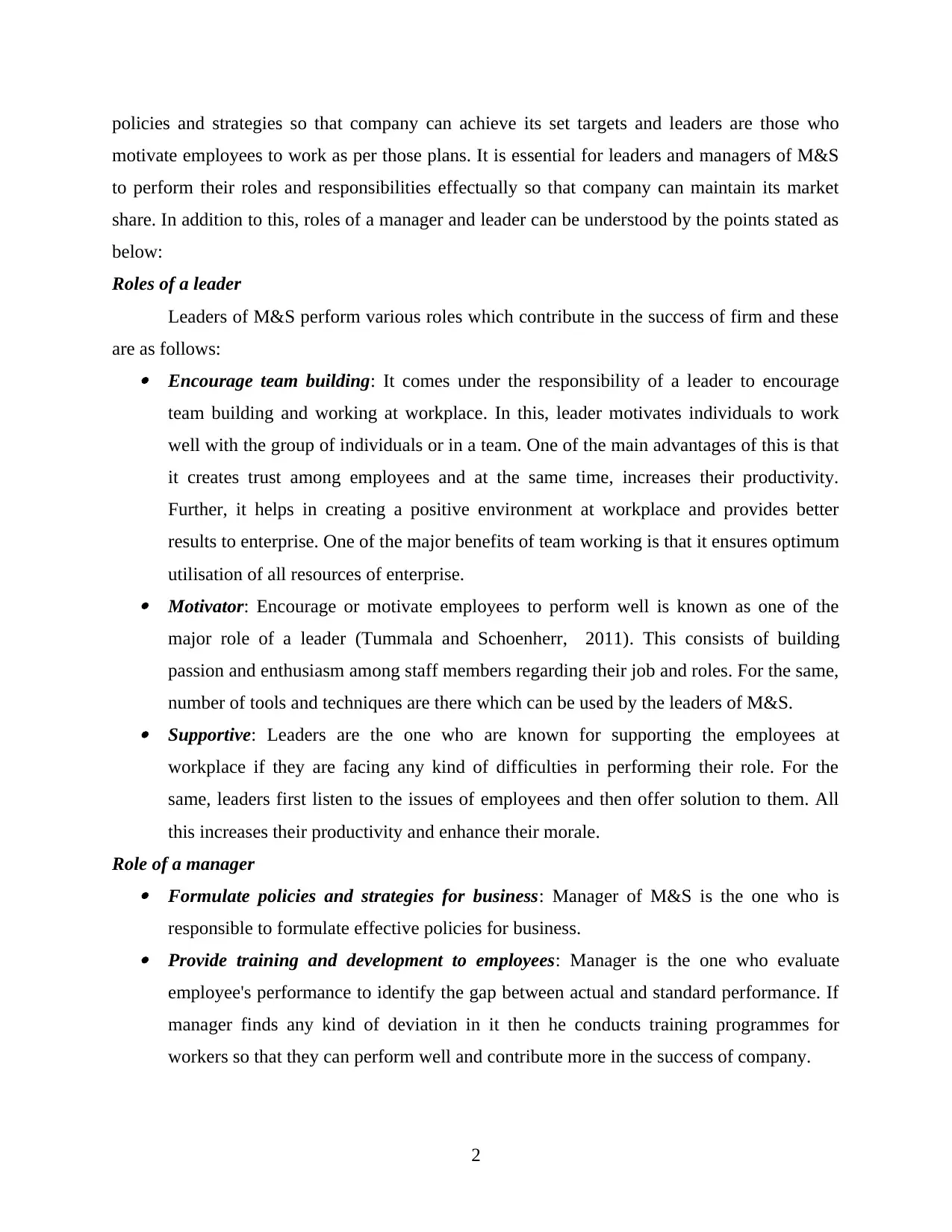
policies and strategies so that company can achieve its set targets and leaders are those who
motivate employees to work as per those plans. It is essential for leaders and managers of M&S
to perform their roles and responsibilities effectually so that company can maintain its market
share. In addition to this, roles of a manager and leader can be understood by the points stated as
below:
Roles of a leader
Leaders of M&S perform various roles which contribute in the success of firm and these
are as follows: Encourage team building: It comes under the responsibility of a leader to encourage
team building and working at workplace. In this, leader motivates individuals to work
well with the group of individuals or in a team. One of the main advantages of this is that
it creates trust among employees and at the same time, increases their productivity.
Further, it helps in creating a positive environment at workplace and provides better
results to enterprise. One of the major benefits of team working is that it ensures optimum
utilisation of all resources of enterprise. Motivator: Encourage or motivate employees to perform well is known as one of the
major role of a leader (Tummala and Schoenherr, 2011). This consists of building
passion and enthusiasm among staff members regarding their job and roles. For the same,
number of tools and techniques are there which can be used by the leaders of M&S. Supportive: Leaders are the one who are known for supporting the employees at
workplace if they are facing any kind of difficulties in performing their role. For the
same, leaders first listen to the issues of employees and then offer solution to them. All
this increases their productivity and enhance their morale.
Role of a manager Formulate policies and strategies for business: Manager of M&S is the one who is
responsible to formulate effective policies for business. Provide training and development to employees: Manager is the one who evaluate
employee's performance to identify the gap between actual and standard performance. If
manager finds any kind of deviation in it then he conducts training programmes for
workers so that they can perform well and contribute more in the success of company.
2
motivate employees to work as per those plans. It is essential for leaders and managers of M&S
to perform their roles and responsibilities effectually so that company can maintain its market
share. In addition to this, roles of a manager and leader can be understood by the points stated as
below:
Roles of a leader
Leaders of M&S perform various roles which contribute in the success of firm and these
are as follows: Encourage team building: It comes under the responsibility of a leader to encourage
team building and working at workplace. In this, leader motivates individuals to work
well with the group of individuals or in a team. One of the main advantages of this is that
it creates trust among employees and at the same time, increases their productivity.
Further, it helps in creating a positive environment at workplace and provides better
results to enterprise. One of the major benefits of team working is that it ensures optimum
utilisation of all resources of enterprise. Motivator: Encourage or motivate employees to perform well is known as one of the
major role of a leader (Tummala and Schoenherr, 2011). This consists of building
passion and enthusiasm among staff members regarding their job and roles. For the same,
number of tools and techniques are there which can be used by the leaders of M&S. Supportive: Leaders are the one who are known for supporting the employees at
workplace if they are facing any kind of difficulties in performing their role. For the
same, leaders first listen to the issues of employees and then offer solution to them. All
this increases their productivity and enhance their morale.
Role of a manager Formulate policies and strategies for business: Manager of M&S is the one who is
responsible to formulate effective policies for business. Provide training and development to employees: Manager is the one who evaluate
employee's performance to identify the gap between actual and standard performance. If
manager finds any kind of deviation in it then he conducts training programmes for
workers so that they can perform well and contribute more in the success of company.
2
Paraphrase This Document
Need a fresh take? Get an instant paraphrase of this document with our AI Paraphraser
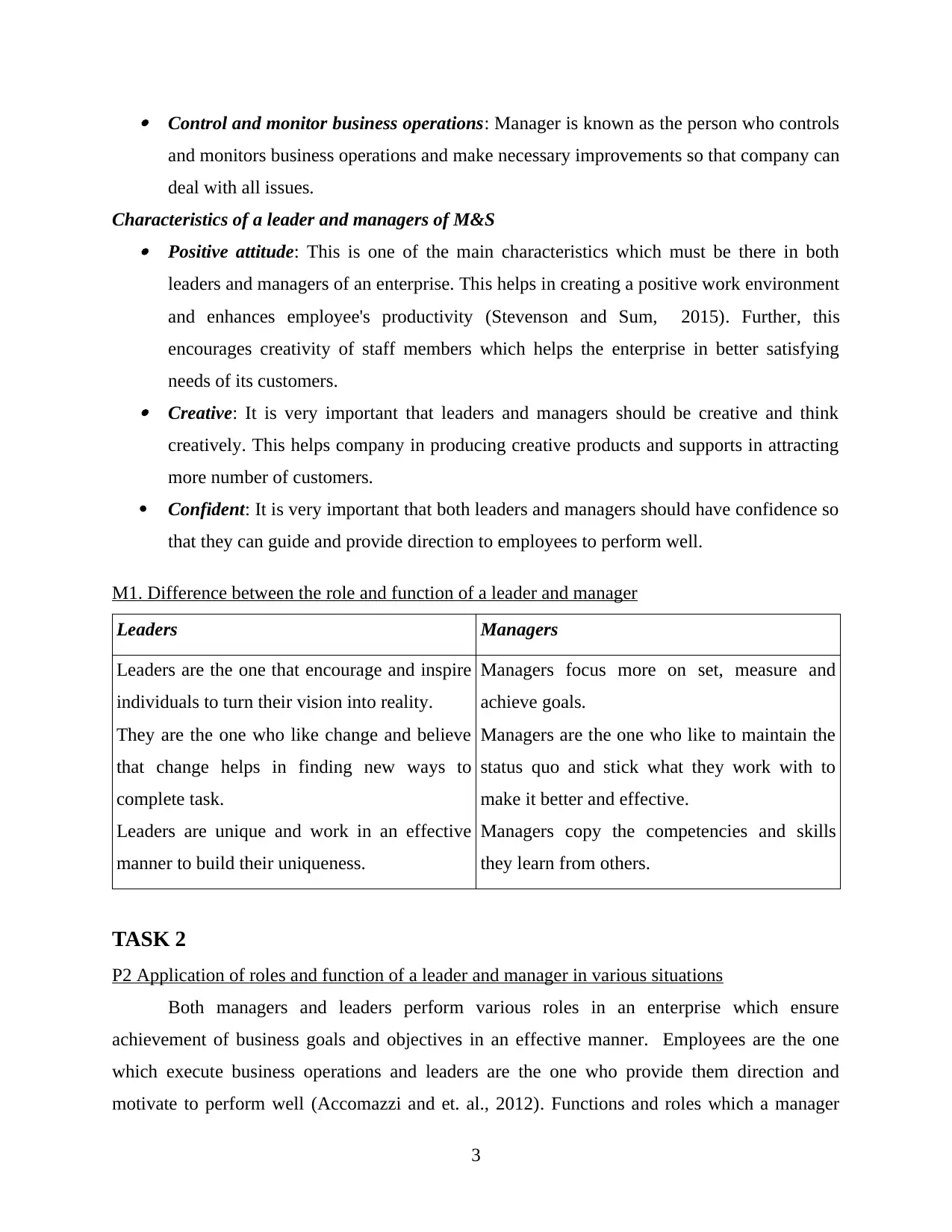
Control and monitor business operations: Manager is known as the person who controls
and monitors business operations and make necessary improvements so that company can
deal with all issues.
Characteristics of a leader and managers of M&S Positive attitude: This is one of the main characteristics which must be there in both
leaders and managers of an enterprise. This helps in creating a positive work environment
and enhances employee's productivity (Stevenson and Sum, 2015). Further, this
encourages creativity of staff members which helps the enterprise in better satisfying
needs of its customers. Creative: It is very important that leaders and managers should be creative and think
creatively. This helps company in producing creative products and supports in attracting
more number of customers.
Confident: It is very important that both leaders and managers should have confidence so
that they can guide and provide direction to employees to perform well.
M1. Difference between the role and function of a leader and manager
Leaders Managers
Leaders are the one that encourage and inspire
individuals to turn their vision into reality.
They are the one who like change and believe
that change helps in finding new ways to
complete task.
Leaders are unique and work in an effective
manner to build their uniqueness.
Managers focus more on set, measure and
achieve goals.
Managers are the one who like to maintain the
status quo and stick what they work with to
make it better and effective.
Managers copy the competencies and skills
they learn from others.
TASK 2
P2 Application of roles and function of a leader and manager in various situations
Both managers and leaders perform various roles in an enterprise which ensure
achievement of business goals and objectives in an effective manner. Employees are the one
which execute business operations and leaders are the one who provide them direction and
motivate to perform well (Accomazzi and et. al., 2012). Functions and roles which a manager
3
and monitors business operations and make necessary improvements so that company can
deal with all issues.
Characteristics of a leader and managers of M&S Positive attitude: This is one of the main characteristics which must be there in both
leaders and managers of an enterprise. This helps in creating a positive work environment
and enhances employee's productivity (Stevenson and Sum, 2015). Further, this
encourages creativity of staff members which helps the enterprise in better satisfying
needs of its customers. Creative: It is very important that leaders and managers should be creative and think
creatively. This helps company in producing creative products and supports in attracting
more number of customers.
Confident: It is very important that both leaders and managers should have confidence so
that they can guide and provide direction to employees to perform well.
M1. Difference between the role and function of a leader and manager
Leaders Managers
Leaders are the one that encourage and inspire
individuals to turn their vision into reality.
They are the one who like change and believe
that change helps in finding new ways to
complete task.
Leaders are unique and work in an effective
manner to build their uniqueness.
Managers focus more on set, measure and
achieve goals.
Managers are the one who like to maintain the
status quo and stick what they work with to
make it better and effective.
Managers copy the competencies and skills
they learn from others.
TASK 2
P2 Application of roles and function of a leader and manager in various situations
Both managers and leaders perform various roles in an enterprise which ensure
achievement of business goals and objectives in an effective manner. Employees are the one
which execute business operations and leaders are the one who provide them direction and
motivate to perform well (Accomazzi and et. al., 2012). Functions and roles which a manager
3
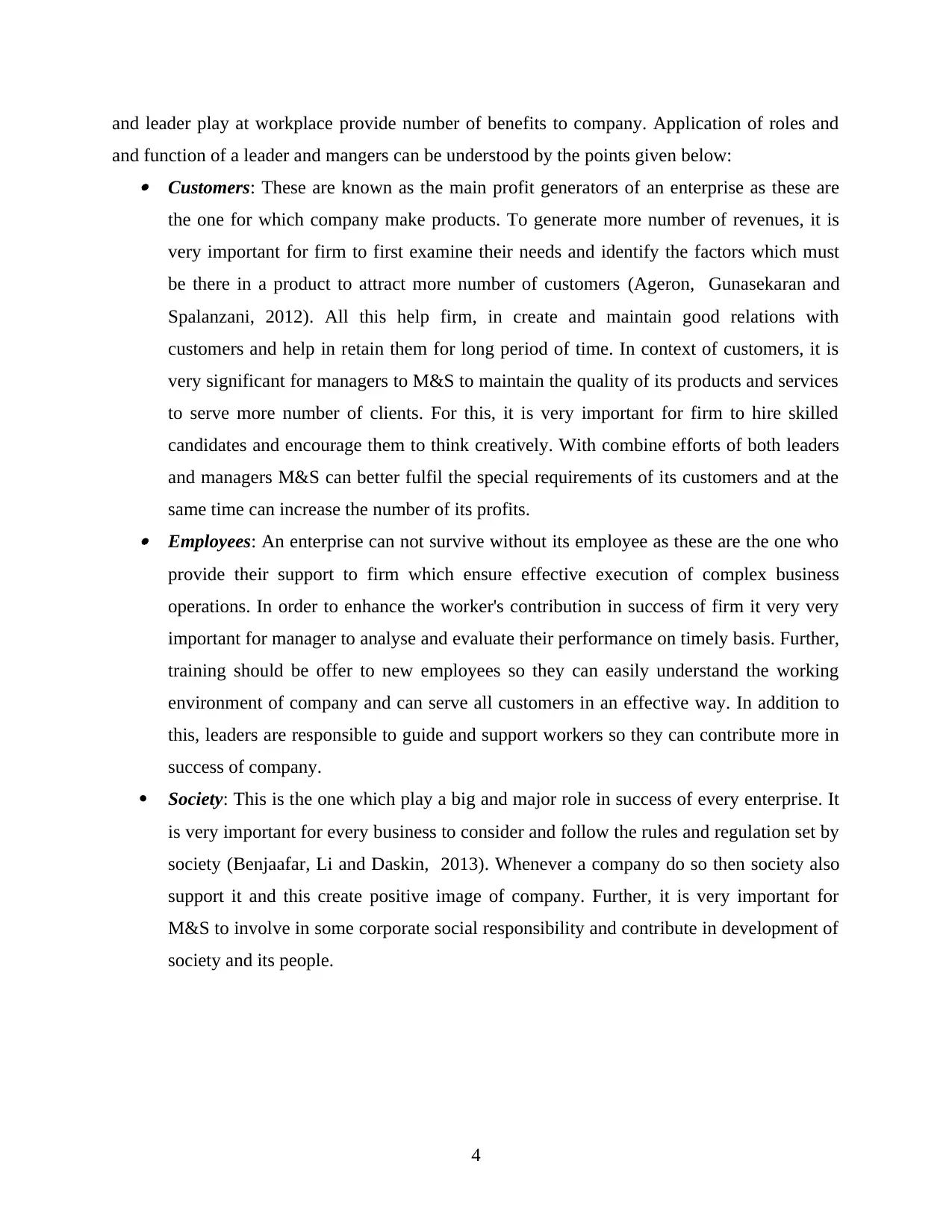
and leader play at workplace provide number of benefits to company. Application of roles and
and function of a leader and mangers can be understood by the points given below: Customers: These are known as the main profit generators of an enterprise as these are
the one for which company make products. To generate more number of revenues, it is
very important for firm to first examine their needs and identify the factors which must
be there in a product to attract more number of customers (Ageron, Gunasekaran and
Spalanzani, 2012). All this help firm, in create and maintain good relations with
customers and help in retain them for long period of time. In context of customers, it is
very significant for managers to M&S to maintain the quality of its products and services
to serve more number of clients. For this, it is very important for firm to hire skilled
candidates and encourage them to think creatively. With combine efforts of both leaders
and managers M&S can better fulfil the special requirements of its customers and at the
same time can increase the number of its profits. Employees: An enterprise can not survive without its employee as these are the one who
provide their support to firm which ensure effective execution of complex business
operations. In order to enhance the worker's contribution in success of firm it very very
important for manager to analyse and evaluate their performance on timely basis. Further,
training should be offer to new employees so they can easily understand the working
environment of company and can serve all customers in an effective way. In addition to
this, leaders are responsible to guide and support workers so they can contribute more in
success of company.
Society: This is the one which play a big and major role in success of every enterprise. It
is very important for every business to consider and follow the rules and regulation set by
society (Benjaafar, Li and Daskin, 2013). Whenever a company do so then society also
support it and this create positive image of company. Further, it is very important for
M&S to involve in some corporate social responsibility and contribute in development of
society and its people.
4
and function of a leader and mangers can be understood by the points given below: Customers: These are known as the main profit generators of an enterprise as these are
the one for which company make products. To generate more number of revenues, it is
very important for firm to first examine their needs and identify the factors which must
be there in a product to attract more number of customers (Ageron, Gunasekaran and
Spalanzani, 2012). All this help firm, in create and maintain good relations with
customers and help in retain them for long period of time. In context of customers, it is
very significant for managers to M&S to maintain the quality of its products and services
to serve more number of clients. For this, it is very important for firm to hire skilled
candidates and encourage them to think creatively. With combine efforts of both leaders
and managers M&S can better fulfil the special requirements of its customers and at the
same time can increase the number of its profits. Employees: An enterprise can not survive without its employee as these are the one who
provide their support to firm which ensure effective execution of complex business
operations. In order to enhance the worker's contribution in success of firm it very very
important for manager to analyse and evaluate their performance on timely basis. Further,
training should be offer to new employees so they can easily understand the working
environment of company and can serve all customers in an effective way. In addition to
this, leaders are responsible to guide and support workers so they can contribute more in
success of company.
Society: This is the one which play a big and major role in success of every enterprise. It
is very important for every business to consider and follow the rules and regulation set by
society (Benjaafar, Li and Daskin, 2013). Whenever a company do so then society also
support it and this create positive image of company. Further, it is very important for
M&S to involve in some corporate social responsibility and contribute in development of
society and its people.
4
⊘ This is a preview!⊘
Do you want full access?
Subscribe today to unlock all pages.

Trusted by 1+ million students worldwide
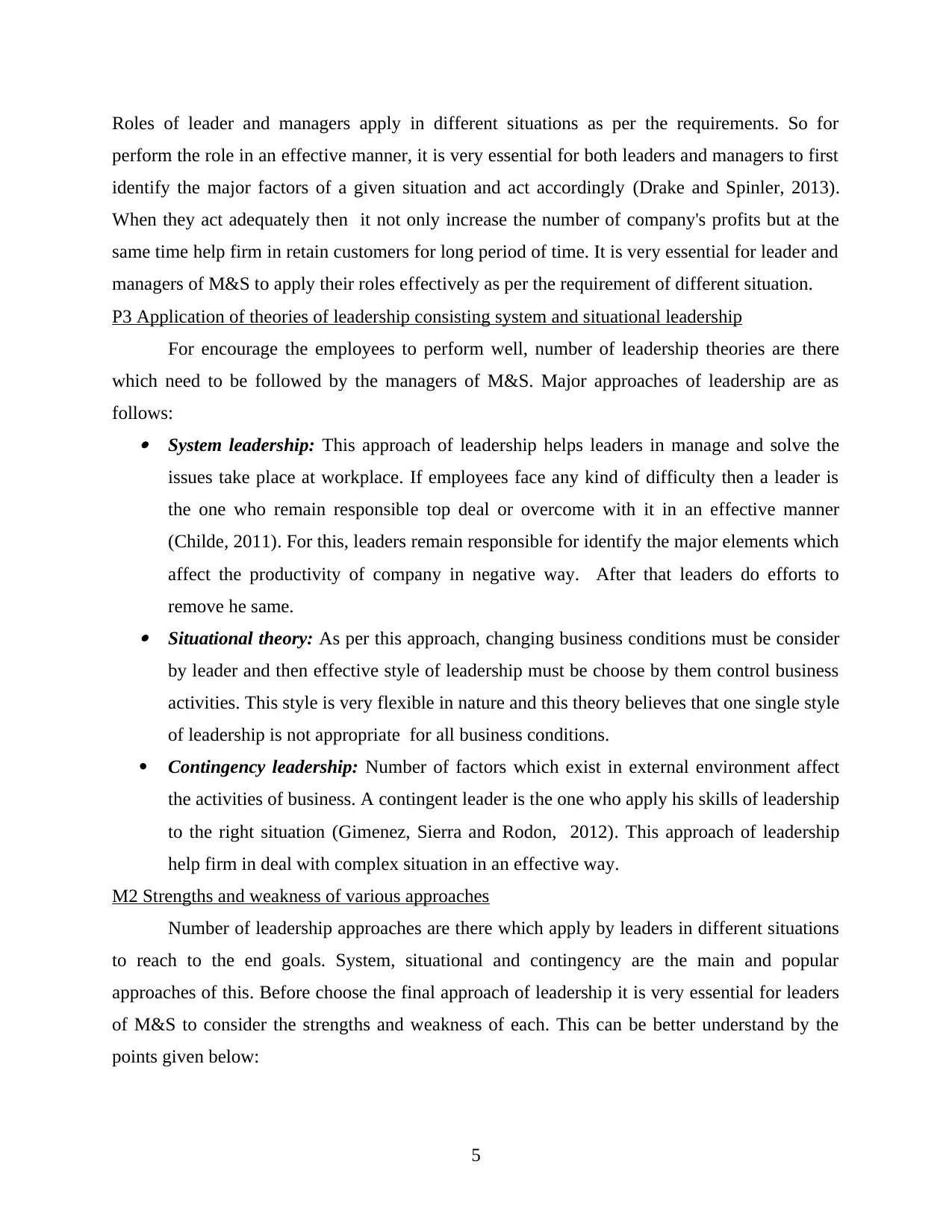
Roles of leader and managers apply in different situations as per the requirements. So for
perform the role in an effective manner, it is very essential for both leaders and managers to first
identify the major factors of a given situation and act accordingly (Drake and Spinler, 2013).
When they act adequately then it not only increase the number of company's profits but at the
same time help firm in retain customers for long period of time. It is very essential for leader and
managers of M&S to apply their roles effectively as per the requirement of different situation.
P3 Application of theories of leadership consisting system and situational leadership
For encourage the employees to perform well, number of leadership theories are there
which need to be followed by the managers of M&S. Major approaches of leadership are as
follows: System leadership: This approach of leadership helps leaders in manage and solve the
issues take place at workplace. If employees face any kind of difficulty then a leader is
the one who remain responsible top deal or overcome with it in an effective manner
(Childe, 2011). For this, leaders remain responsible for identify the major elements which
affect the productivity of company in negative way. After that leaders do efforts to
remove he same. Situational theory: As per this approach, changing business conditions must be consider
by leader and then effective style of leadership must be choose by them control business
activities. This style is very flexible in nature and this theory believes that one single style
of leadership is not appropriate for all business conditions.
Contingency leadership: Number of factors which exist in external environment affect
the activities of business. A contingent leader is the one who apply his skills of leadership
to the right situation (Gimenez, Sierra and Rodon, 2012). This approach of leadership
help firm in deal with complex situation in an effective way.
M2 Strengths and weakness of various approaches
Number of leadership approaches are there which apply by leaders in different situations
to reach to the end goals. System, situational and contingency are the main and popular
approaches of this. Before choose the final approach of leadership it is very essential for leaders
of M&S to consider the strengths and weakness of each. This can be better understand by the
points given below:
5
perform the role in an effective manner, it is very essential for both leaders and managers to first
identify the major factors of a given situation and act accordingly (Drake and Spinler, 2013).
When they act adequately then it not only increase the number of company's profits but at the
same time help firm in retain customers for long period of time. It is very essential for leader and
managers of M&S to apply their roles effectively as per the requirement of different situation.
P3 Application of theories of leadership consisting system and situational leadership
For encourage the employees to perform well, number of leadership theories are there
which need to be followed by the managers of M&S. Major approaches of leadership are as
follows: System leadership: This approach of leadership helps leaders in manage and solve the
issues take place at workplace. If employees face any kind of difficulty then a leader is
the one who remain responsible top deal or overcome with it in an effective manner
(Childe, 2011). For this, leaders remain responsible for identify the major elements which
affect the productivity of company in negative way. After that leaders do efforts to
remove he same. Situational theory: As per this approach, changing business conditions must be consider
by leader and then effective style of leadership must be choose by them control business
activities. This style is very flexible in nature and this theory believes that one single style
of leadership is not appropriate for all business conditions.
Contingency leadership: Number of factors which exist in external environment affect
the activities of business. A contingent leader is the one who apply his skills of leadership
to the right situation (Gimenez, Sierra and Rodon, 2012). This approach of leadership
help firm in deal with complex situation in an effective way.
M2 Strengths and weakness of various approaches
Number of leadership approaches are there which apply by leaders in different situations
to reach to the end goals. System, situational and contingency are the main and popular
approaches of this. Before choose the final approach of leadership it is very essential for leaders
of M&S to consider the strengths and weakness of each. This can be better understand by the
points given below:
5
Paraphrase This Document
Need a fresh take? Get an instant paraphrase of this document with our AI Paraphraser
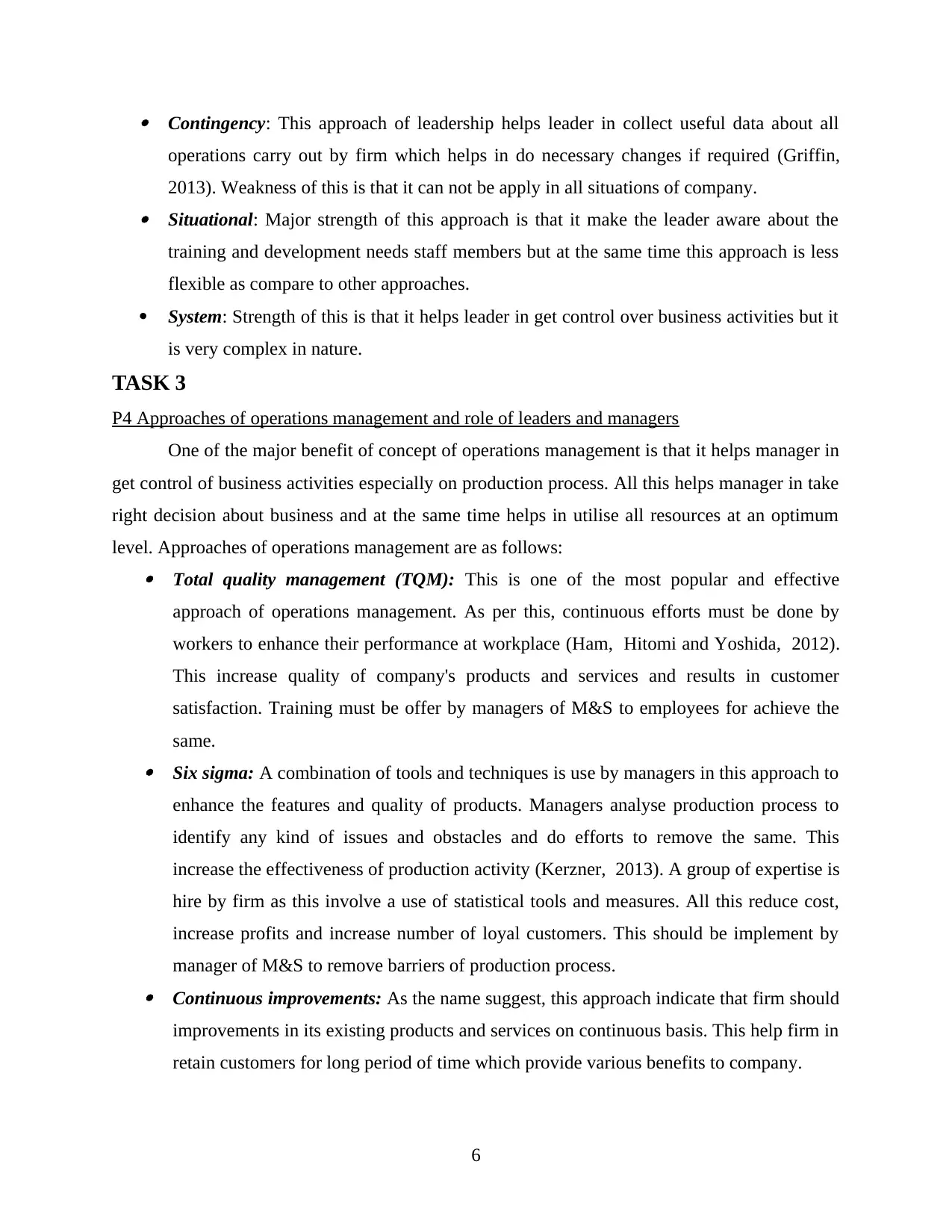
Contingency: This approach of leadership helps leader in collect useful data about all
operations carry out by firm which helps in do necessary changes if required (Griffin,
2013). Weakness of this is that it can not be apply in all situations of company. Situational: Major strength of this approach is that it make the leader aware about the
training and development needs staff members but at the same time this approach is less
flexible as compare to other approaches.
System: Strength of this is that it helps leader in get control over business activities but it
is very complex in nature.
TASK 3
P4 Approaches of operations management and role of leaders and managers
One of the major benefit of concept of operations management is that it helps manager in
get control of business activities especially on production process. All this helps manager in take
right decision about business and at the same time helps in utilise all resources at an optimum
level. Approaches of operations management are as follows: Total quality management (TQM): This is one of the most popular and effective
approach of operations management. As per this, continuous efforts must be done by
workers to enhance their performance at workplace (Ham, Hitomi and Yoshida, 2012).
This increase quality of company's products and services and results in customer
satisfaction. Training must be offer by managers of M&S to employees for achieve the
same. Six sigma: A combination of tools and techniques is use by managers in this approach to
enhance the features and quality of products. Managers analyse production process to
identify any kind of issues and obstacles and do efforts to remove the same. This
increase the effectiveness of production activity (Kerzner, 2013). A group of expertise is
hire by firm as this involve a use of statistical tools and measures. All this reduce cost,
increase profits and increase number of loyal customers. This should be implement by
manager of M&S to remove barriers of production process. Continuous improvements: As the name suggest, this approach indicate that firm should
improvements in its existing products and services on continuous basis. This help firm in
retain customers for long period of time which provide various benefits to company.
6
operations carry out by firm which helps in do necessary changes if required (Griffin,
2013). Weakness of this is that it can not be apply in all situations of company. Situational: Major strength of this approach is that it make the leader aware about the
training and development needs staff members but at the same time this approach is less
flexible as compare to other approaches.
System: Strength of this is that it helps leader in get control over business activities but it
is very complex in nature.
TASK 3
P4 Approaches of operations management and role of leaders and managers
One of the major benefit of concept of operations management is that it helps manager in
get control of business activities especially on production process. All this helps manager in take
right decision about business and at the same time helps in utilise all resources at an optimum
level. Approaches of operations management are as follows: Total quality management (TQM): This is one of the most popular and effective
approach of operations management. As per this, continuous efforts must be done by
workers to enhance their performance at workplace (Ham, Hitomi and Yoshida, 2012).
This increase quality of company's products and services and results in customer
satisfaction. Training must be offer by managers of M&S to employees for achieve the
same. Six sigma: A combination of tools and techniques is use by managers in this approach to
enhance the features and quality of products. Managers analyse production process to
identify any kind of issues and obstacles and do efforts to remove the same. This
increase the effectiveness of production activity (Kerzner, 2013). A group of expertise is
hire by firm as this involve a use of statistical tools and measures. All this reduce cost,
increase profits and increase number of loyal customers. This should be implement by
manager of M&S to remove barriers of production process. Continuous improvements: As the name suggest, this approach indicate that firm should
improvements in its existing products and services on continuous basis. This help firm in
retain customers for long period of time which provide various benefits to company.
6
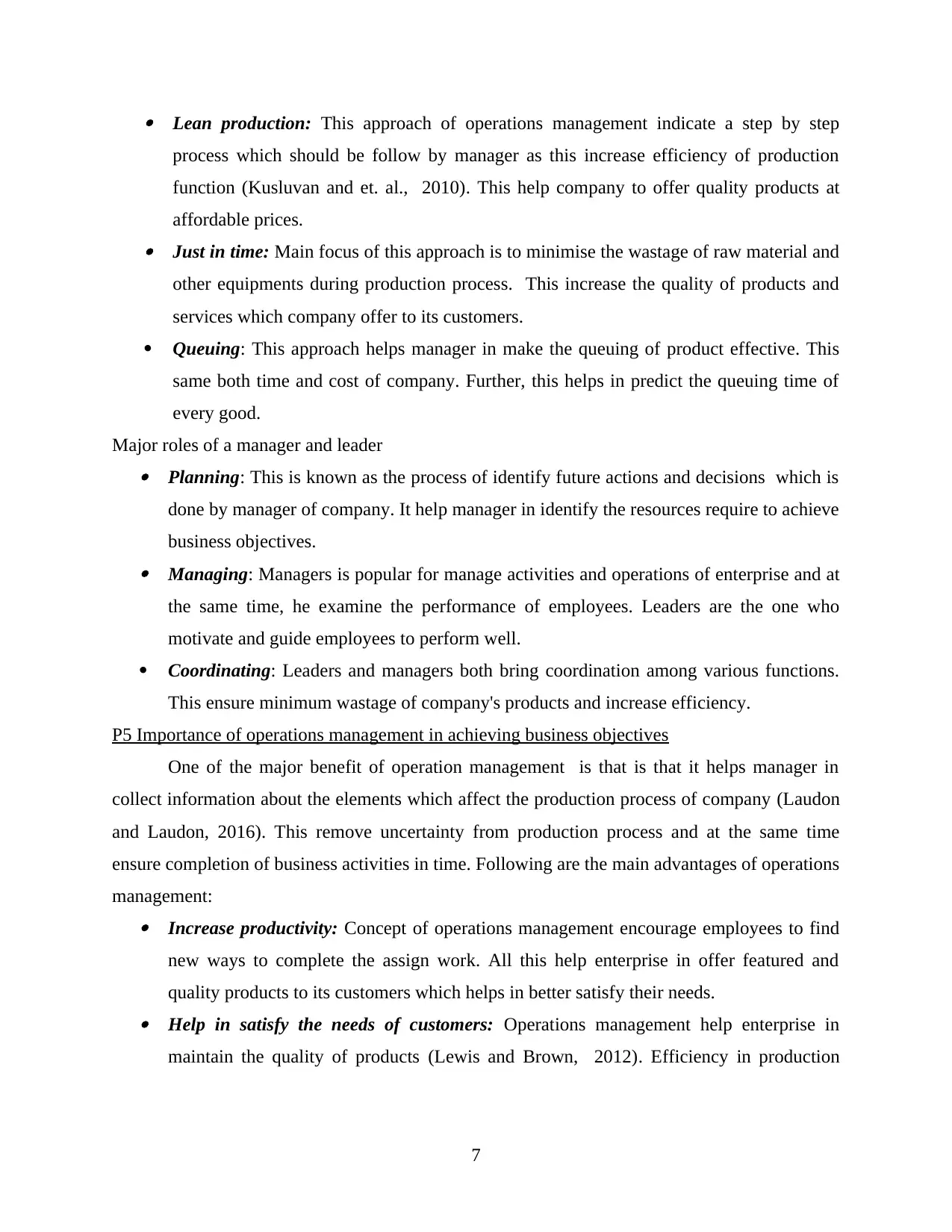
Lean production: This approach of operations management indicate a step by step
process which should be follow by manager as this increase efficiency of production
function (Kusluvan and et. al., 2010). This help company to offer quality products at
affordable prices. Just in time: Main focus of this approach is to minimise the wastage of raw material and
other equipments during production process. This increase the quality of products and
services which company offer to its customers.
Queuing: This approach helps manager in make the queuing of product effective. This
same both time and cost of company. Further, this helps in predict the queuing time of
every good.
Major roles of a manager and leader Planning: This is known as the process of identify future actions and decisions which is
done by manager of company. It help manager in identify the resources require to achieve
business objectives. Managing: Managers is popular for manage activities and operations of enterprise and at
the same time, he examine the performance of employees. Leaders are the one who
motivate and guide employees to perform well.
Coordinating: Leaders and managers both bring coordination among various functions.
This ensure minimum wastage of company's products and increase efficiency.
P5 Importance of operations management in achieving business objectives
One of the major benefit of operation management is that is that it helps manager in
collect information about the elements which affect the production process of company (Laudon
and Laudon, 2016). This remove uncertainty from production process and at the same time
ensure completion of business activities in time. Following are the main advantages of operations
management: Increase productivity: Concept of operations management encourage employees to find
new ways to complete the assign work. All this help enterprise in offer featured and
quality products to its customers which helps in better satisfy their needs. Help in satisfy the needs of customers: Operations management help enterprise in
maintain the quality of products (Lewis and Brown, 2012). Efficiency in production
7
process which should be follow by manager as this increase efficiency of production
function (Kusluvan and et. al., 2010). This help company to offer quality products at
affordable prices. Just in time: Main focus of this approach is to minimise the wastage of raw material and
other equipments during production process. This increase the quality of products and
services which company offer to its customers.
Queuing: This approach helps manager in make the queuing of product effective. This
same both time and cost of company. Further, this helps in predict the queuing time of
every good.
Major roles of a manager and leader Planning: This is known as the process of identify future actions and decisions which is
done by manager of company. It help manager in identify the resources require to achieve
business objectives. Managing: Managers is popular for manage activities and operations of enterprise and at
the same time, he examine the performance of employees. Leaders are the one who
motivate and guide employees to perform well.
Coordinating: Leaders and managers both bring coordination among various functions.
This ensure minimum wastage of company's products and increase efficiency.
P5 Importance of operations management in achieving business objectives
One of the major benefit of operation management is that is that it helps manager in
collect information about the elements which affect the production process of company (Laudon
and Laudon, 2016). This remove uncertainty from production process and at the same time
ensure completion of business activities in time. Following are the main advantages of operations
management: Increase productivity: Concept of operations management encourage employees to find
new ways to complete the assign work. All this help enterprise in offer featured and
quality products to its customers which helps in better satisfy their needs. Help in satisfy the needs of customers: Operations management help enterprise in
maintain the quality of products (Lewis and Brown, 2012). Efficiency in production
7
⊘ This is a preview!⊘
Do you want full access?
Subscribe today to unlock all pages.

Trusted by 1+ million students worldwide
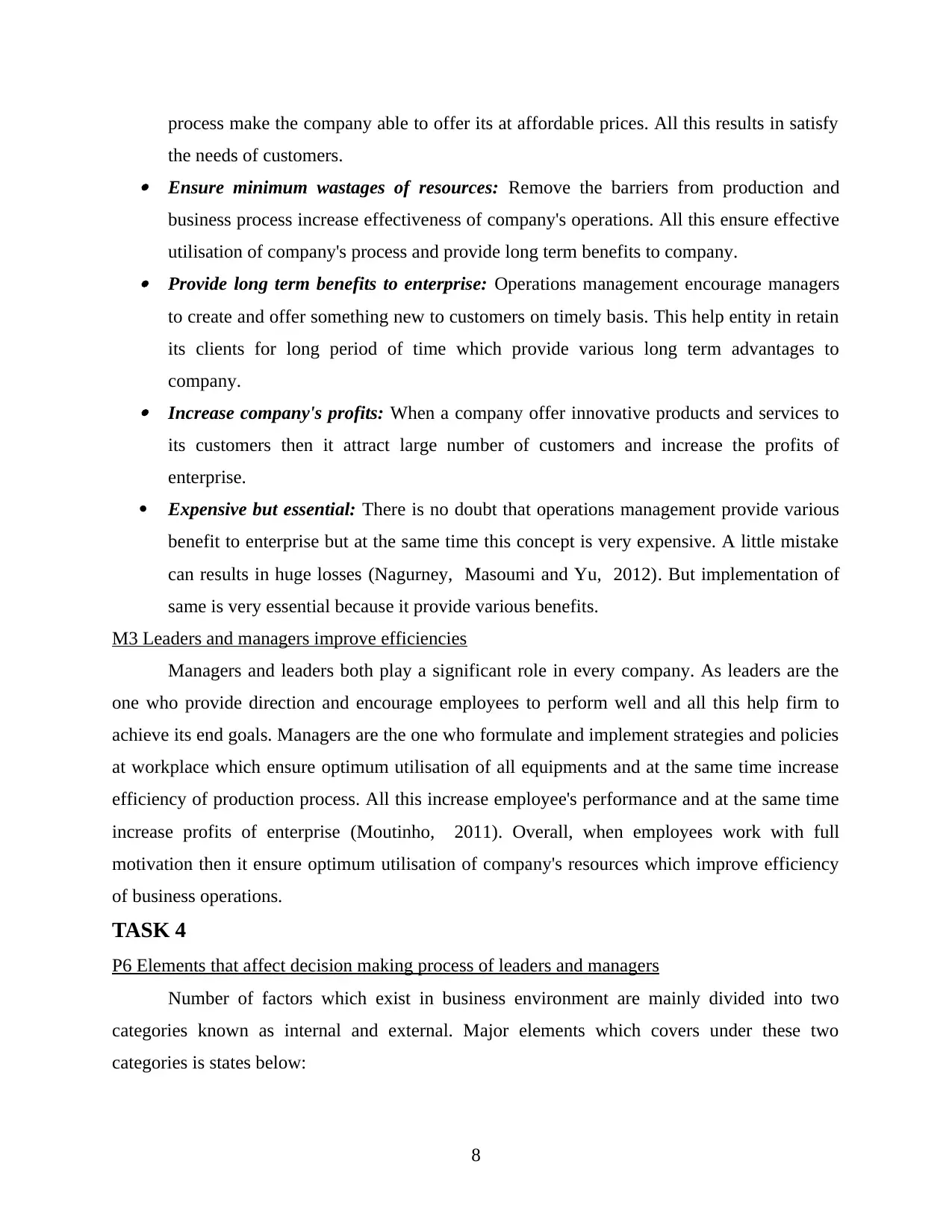
process make the company able to offer its at affordable prices. All this results in satisfy
the needs of customers. Ensure minimum wastages of resources: Remove the barriers from production and
business process increase effectiveness of company's operations. All this ensure effective
utilisation of company's process and provide long term benefits to company. Provide long term benefits to enterprise: Operations management encourage managers
to create and offer something new to customers on timely basis. This help entity in retain
its clients for long period of time which provide various long term advantages to
company. Increase company's profits: When a company offer innovative products and services to
its customers then it attract large number of customers and increase the profits of
enterprise.
Expensive but essential: There is no doubt that operations management provide various
benefit to enterprise but at the same time this concept is very expensive. A little mistake
can results in huge losses (Nagurney, Masoumi and Yu, 2012). But implementation of
same is very essential because it provide various benefits.
M3 Leaders and managers improve efficiencies
Managers and leaders both play a significant role in every company. As leaders are the
one who provide direction and encourage employees to perform well and all this help firm to
achieve its end goals. Managers are the one who formulate and implement strategies and policies
at workplace which ensure optimum utilisation of all equipments and at the same time increase
efficiency of production process. All this increase employee's performance and at the same time
increase profits of enterprise (Moutinho, 2011). Overall, when employees work with full
motivation then it ensure optimum utilisation of company's resources which improve efficiency
of business operations.
TASK 4
P6 Elements that affect decision making process of leaders and managers
Number of factors which exist in business environment are mainly divided into two
categories known as internal and external. Major elements which covers under these two
categories is states below:
8
the needs of customers. Ensure minimum wastages of resources: Remove the barriers from production and
business process increase effectiveness of company's operations. All this ensure effective
utilisation of company's process and provide long term benefits to company. Provide long term benefits to enterprise: Operations management encourage managers
to create and offer something new to customers on timely basis. This help entity in retain
its clients for long period of time which provide various long term advantages to
company. Increase company's profits: When a company offer innovative products and services to
its customers then it attract large number of customers and increase the profits of
enterprise.
Expensive but essential: There is no doubt that operations management provide various
benefit to enterprise but at the same time this concept is very expensive. A little mistake
can results in huge losses (Nagurney, Masoumi and Yu, 2012). But implementation of
same is very essential because it provide various benefits.
M3 Leaders and managers improve efficiencies
Managers and leaders both play a significant role in every company. As leaders are the
one who provide direction and encourage employees to perform well and all this help firm to
achieve its end goals. Managers are the one who formulate and implement strategies and policies
at workplace which ensure optimum utilisation of all equipments and at the same time increase
efficiency of production process. All this increase employee's performance and at the same time
increase profits of enterprise (Moutinho, 2011). Overall, when employees work with full
motivation then it ensure optimum utilisation of company's resources which improve efficiency
of business operations.
TASK 4
P6 Elements that affect decision making process of leaders and managers
Number of factors which exist in business environment are mainly divided into two
categories known as internal and external. Major elements which covers under these two
categories is states below:
8
Paraphrase This Document
Need a fresh take? Get an instant paraphrase of this document with our AI Paraphraser
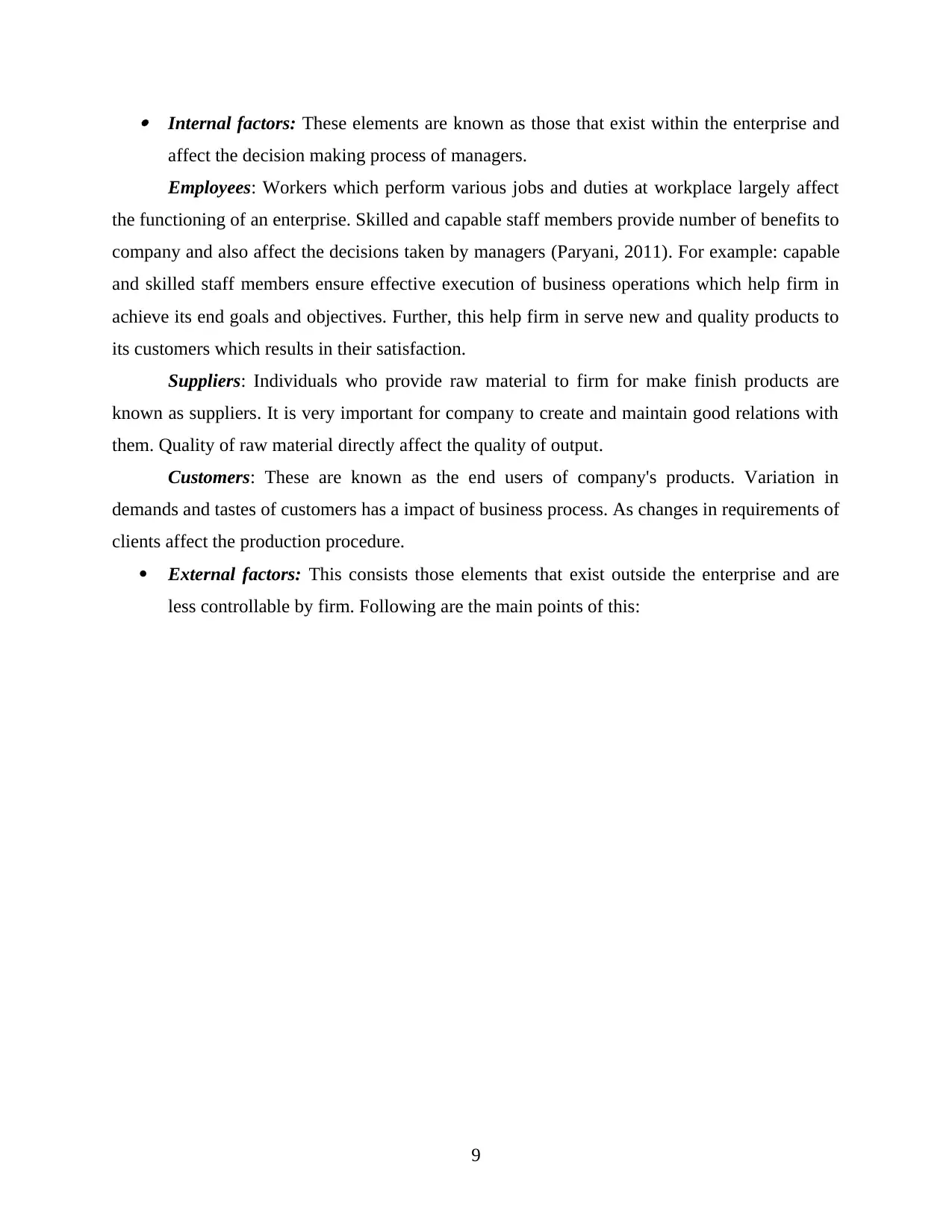
Internal factors: These elements are known as those that exist within the enterprise and
affect the decision making process of managers.
Employees: Workers which perform various jobs and duties at workplace largely affect
the functioning of an enterprise. Skilled and capable staff members provide number of benefits to
company and also affect the decisions taken by managers (Paryani, 2011). For example: capable
and skilled staff members ensure effective execution of business operations which help firm in
achieve its end goals and objectives. Further, this help firm in serve new and quality products to
its customers which results in their satisfaction.
Suppliers: Individuals who provide raw material to firm for make finish products are
known as suppliers. It is very important for company to create and maintain good relations with
them. Quality of raw material directly affect the quality of output.
Customers: These are known as the end users of company's products. Variation in
demands and tastes of customers has a impact of business process. As changes in requirements of
clients affect the production procedure.
External factors: This consists those elements that exist outside the enterprise and are
less controllable by firm. Following are the main points of this:
9
affect the decision making process of managers.
Employees: Workers which perform various jobs and duties at workplace largely affect
the functioning of an enterprise. Skilled and capable staff members provide number of benefits to
company and also affect the decisions taken by managers (Paryani, 2011). For example: capable
and skilled staff members ensure effective execution of business operations which help firm in
achieve its end goals and objectives. Further, this help firm in serve new and quality products to
its customers which results in their satisfaction.
Suppliers: Individuals who provide raw material to firm for make finish products are
known as suppliers. It is very important for company to create and maintain good relations with
them. Quality of raw material directly affect the quality of output.
Customers: These are known as the end users of company's products. Variation in
demands and tastes of customers has a impact of business process. As changes in requirements of
clients affect the production procedure.
External factors: This consists those elements that exist outside the enterprise and are
less controllable by firm. Following are the main points of this:
9
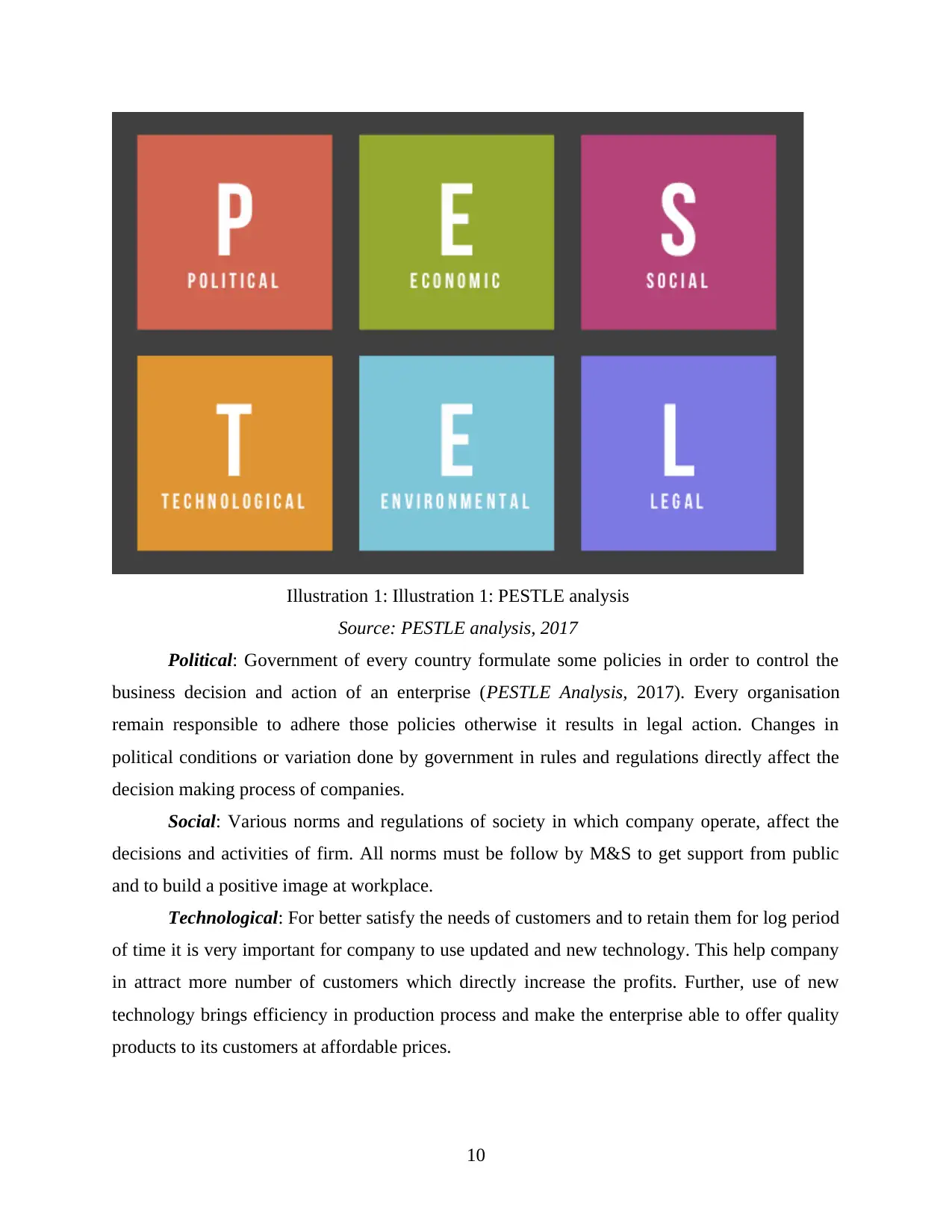
Illustration 1: Illustration 1: PESTLE analysis
Source: PESTLE analysis, 2017
Political: Government of every country formulate some policies in order to control the
business decision and action of an enterprise (PESTLE Analysis, 2017). Every organisation
remain responsible to adhere those policies otherwise it results in legal action. Changes in
political conditions or variation done by government in rules and regulations directly affect the
decision making process of companies.
Social: Various norms and regulations of society in which company operate, affect the
decisions and activities of firm. All norms must be follow by M&S to get support from public
and to build a positive image at workplace.
Technological: For better satisfy the needs of customers and to retain them for log period
of time it is very important for company to use updated and new technology. This help company
in attract more number of customers which directly increase the profits. Further, use of new
technology brings efficiency in production process and make the enterprise able to offer quality
products to its customers at affordable prices.
10
Source: PESTLE analysis, 2017
Political: Government of every country formulate some policies in order to control the
business decision and action of an enterprise (PESTLE Analysis, 2017). Every organisation
remain responsible to adhere those policies otherwise it results in legal action. Changes in
political conditions or variation done by government in rules and regulations directly affect the
decision making process of companies.
Social: Various norms and regulations of society in which company operate, affect the
decisions and activities of firm. All norms must be follow by M&S to get support from public
and to build a positive image at workplace.
Technological: For better satisfy the needs of customers and to retain them for log period
of time it is very important for company to use updated and new technology. This help company
in attract more number of customers which directly increase the profits. Further, use of new
technology brings efficiency in production process and make the enterprise able to offer quality
products to its customers at affordable prices.
10
⊘ This is a preview!⊘
Do you want full access?
Subscribe today to unlock all pages.

Trusted by 1+ million students worldwide
1 out of 15
Related Documents
Your All-in-One AI-Powered Toolkit for Academic Success.
+13062052269
info@desklib.com
Available 24*7 on WhatsApp / Email
![[object Object]](/_next/static/media/star-bottom.7253800d.svg)
Unlock your academic potential
Copyright © 2020–2025 A2Z Services. All Rights Reserved. Developed and managed by ZUCOL.





